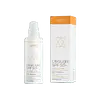What's inside
What's inside
 Key Ingredients
Key Ingredients

 Benefits
Benefits

 Concerns
Concerns

 Ingredients Side-by-side
Ingredients Side-by-side

Water
Skin ConditioningC12-15 Alkyl Benzoate
AntimicrobialDiethylamino Hydroxybenzoyl Hexyl Benzoate
UV FilterGlycerin
HumectantIsopropyl Palmitate
EmollientEthylhexyl Salicylate
UV AbsorberEthylhexyl Triazone
UV AbsorberPotassium Cetyl Phosphate
EmulsifyingPanthenol
Skin ConditioningBis-Ethylhexyloxyphenol Methoxyphenyl Triazine
Skin ConditioningCetearyl Alcohol
EmollientTocopheryl Acetate
AntioxidantDiethylhexyl Butamido Triazone
UV AbsorberGlyceryl Stearate
EmollientXanthan Gum
EmulsifyingPolyglyceryl-2 Dipolyhydroxystearate
Skin ConditioningAcacia Senegal Gum
MaskingAspartic Acid
MaskingCaprylyl Glycol
EmollientCaprylhydroxamic Acid
Aminomethyl Propanol
BufferingTetrasodium Iminodisuccinate
Citric Acid
BufferingFumaric Acid
BufferingMaleic Acid
BufferingMalic Acid
BufferingWater, C12-15 Alkyl Benzoate, Diethylamino Hydroxybenzoyl Hexyl Benzoate, Glycerin, Isopropyl Palmitate, Ethylhexyl Salicylate, Ethylhexyl Triazone, Potassium Cetyl Phosphate, Panthenol, Bis-Ethylhexyloxyphenol Methoxyphenyl Triazine, Cetearyl Alcohol, Tocopheryl Acetate, Diethylhexyl Butamido Triazone, Glyceryl Stearate, Xanthan Gum, Polyglyceryl-2 Dipolyhydroxystearate, Acacia Senegal Gum, Aspartic Acid, Caprylyl Glycol, Caprylhydroxamic Acid, Aminomethyl Propanol, Tetrasodium Iminodisuccinate, Citric Acid, Fumaric Acid, Maleic Acid, Malic Acid
Water
Skin ConditioningPropylene Glycol Diheptanoate
EmollientDiethylamino Hydroxybenzoyl Hexyl Benzoate
UV FilterDicaprylyl Ether
EmollientPhenylbenzimidazole Sulfonic Acid
UV AbsorberDisodium Phenyl Dibenzimidazole Tetrasulfonate
UV AbsorberPentylene Glycol
Skin ConditioningPolyglyceryl-6 Stearate
EmollientBis-Ethylhexyloxyphenol Methoxyphenyl Triazine
Skin ConditioningEthylhexyl Triazone
UV AbsorberNiacinamide
SmoothingTriethyl Citrate
MaskingSilica
AbrasiveDiisostearoyl Polyglyceryl-3 Dimer Dilinoleate
EmollientHydroxylauroyl Phytosphingosine
Skin ConditioningCaprylic/Capric Triglyceride
Masking1,2-Heptanediol
Skin ConditioningCetearyl Alcohol
EmollientGlyceryl Stearate
EmollientSodium Gluconate
Skin ConditioningSodium Hydroxide
BufferingSodium Stearoyl Glutamate
CleansingPolyglyceryl-6 Behenate
Emulsion StabilisingXanthan Gum
EmulsifyingWater, Propylene Glycol Diheptanoate, Diethylamino Hydroxybenzoyl Hexyl Benzoate, Dicaprylyl Ether, Phenylbenzimidazole Sulfonic Acid, Disodium Phenyl Dibenzimidazole Tetrasulfonate, Pentylene Glycol, Polyglyceryl-6 Stearate, Bis-Ethylhexyloxyphenol Methoxyphenyl Triazine, Ethylhexyl Triazone, Niacinamide, Triethyl Citrate, Silica, Diisostearoyl Polyglyceryl-3 Dimer Dilinoleate, Hydroxylauroyl Phytosphingosine, Caprylic/Capric Triglyceride, 1,2-Heptanediol, Cetearyl Alcohol, Glyceryl Stearate, Sodium Gluconate, Sodium Hydroxide, Sodium Stearoyl Glutamate, Polyglyceryl-6 Behenate, Xanthan Gum
 Reviews
Reviews

Ingredients Explained
These ingredients are found in both products.
Ingredients higher up in an ingredient list are typically present in a larger amount.
You might know this ingredient as Tinosorb S or Bemotrizinol. It is a UV filter that covers both UVA and UVB rays.
This ingredient has two peak UV absorption peaks ( 310 and 340 nm) and is able to absorb both UV-A and UV-B rays. This ingredient works by preventing UV rays from reaching and damaging your skin.
On top of that - it is highly photostable and helps prevent the photodegration of other sunscreen ingredients such as avobenzone.
Tinosorb S is allowed in the EU, Australia, and Asia. It is close to being approved by the FDA and we'll hopefully get this ingredient in the U.S. by late 2025.
Fun fact: Tinosorb S is the most effective UV absorber at maximum concentration (measured by SPF) permitted in the EU.
This ingredient is oil-soluble, so your oil-cleansers will take this right off at night.
Learn more about Bis-Ethylhexyloxyphenol Methoxyphenyl TriazineCetearyl alcohol is a mixture of two fatty alcohols: cetyl alcohol and stearyl alcohol. It is mainly used as an emulsifier. Emulsifiers help prevent the separation of oils and products. Due to its composition, it can also be used to thicken a product or help create foam.
Cetearyl alcohol is an emollient. Emollients help soothe and hydrate the skin by trapping moisture.
Studies show Cetearyl alcohol is non-toxic and non-irritating. The FDA allows products labeled "alcohol-free" to have fatty alcohols.
This ingredient is usually derived from plant oils such as palm, vegetable, or coconut oils. There is debate on whether this ingredient will cause acne.
Due to the fatty acid base, this ingredient may not be Malassezia folliculitis safe.
Learn more about Cetearyl AlcoholDiethylamino Hydroxybenzoyl Hexyl Benzoate (DHHB) is a chemical UV-A absorber. It is formulated for high UVA protection (320-400 nm).
DHHB is well-liked for:
DHHB has been approved by the EU, Japan, Taiwan, and South America for use up to 10%. Unfortunately, it has not been approved for use in the US or Canada due to slow regulatory processes.
This ingredient is soluble in oils, fats, and lipids.
Learn more about Diethylamino Hydroxybenzoyl Hexyl BenzoateEthylhexyl Triazone is a modern chemical sunscreen that protects from UV-B radiation.
It is the most effective of existing UV-B filters, as it provides the highest level of photo-stable absorption. It protects from the entire UV-B range (280 to 320nm), with it's highest level of protection at 314nm.
Ethylhexyl Triazone is oil soluble, oderless and colorless, which mean it is able to be incorporated into a variety of different formulations.
It is not currently available within the United States due to slow changing FDA regulations. Outside of the US, it is used in formulations at concentrations up to 5%.
Learn more about Ethylhexyl TriazoneGlyceryl Stearate is a mix of glycerin and stearic acid.
It is used to stabilize the mixing of water and oil ingredients. By preventing these ingredients from separating, it can help elongate shelf life. It can also help thicken the product's texture.
As an emollient, it helps soften skin and supports barrier-replenishing ingredients.
In cosmetics, Glyceryl Stearate is often made from vegetable oils or synthetically produced.
This ingredient may not be fungal-acne safe
Fun fact: The human body also creates Glyceryl Stearate naturally.
Learn more about Glyceryl StearateWater. It's the most common cosmetic ingredient of all. You'll usually see it at the top of ingredient lists, meaning that it makes up the largest part of the product.
So why is it so popular? Water most often acts as a solvent - this means that it helps dissolve other ingredients into the formulation.
You'll also recognize water as that liquid we all need to stay alive. If you see this, drink a glass of water. Stay hydrated!
Learn more about WaterXanthan gum is used as a stabilizer and thickener within cosmetic products. It helps give products a sticky, thick feeling - preventing them from being too runny.
On the technical side of things, xanthan gum is a polysaccharide - a combination consisting of multiple sugar molecules bonded together.
Xanthan gum is a pretty common and great ingredient. It is a natural, non-toxic, non-irritating ingredient that is also commonly used in food products.
Learn more about Xanthan Gum